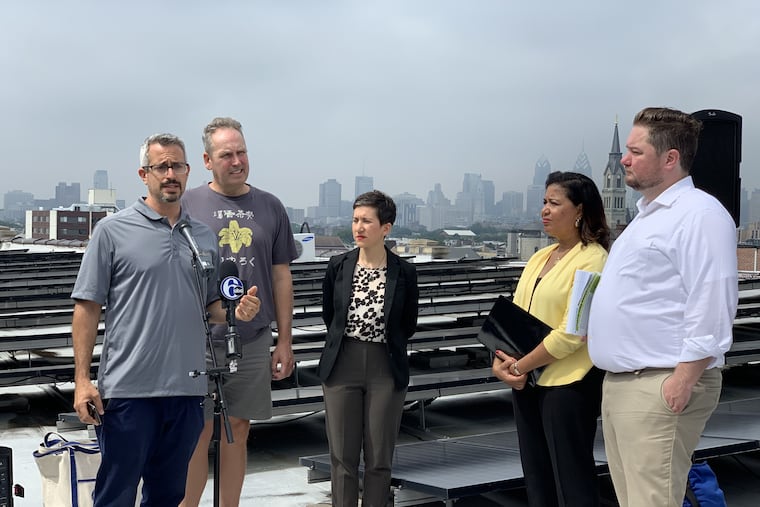Clean energy market added 5,000 jobs in 2018, new report shows
But the government could be a lot more aggressive in setting targets and creating incentives for clean energy.

Pennsylvania’s clean energy job market grew by 6 percent to reach 90,772 jobs last year, according to a recent report. The hottest sector for hiring was in installation, a solar executive said, and to ensure future growth, Philadelphia’s leaders in renewable energy called for more local incentives and much more aggressive state energy goals.
“We need to challenge the government to think in a way beyond the traditional boxes in how we protect the planet [and] give people sustainable jobs,” said Councilwoman Maria Quiñones-Sánchez, who attended a news conference Tuesday on the newly released clean energy report from E2, also known as Environmental Entrepreneurs, a national, nonpartisan business group supporting research-driven economic and environmental policies.
The state has seen a 60 percent growth in its clean technology workforce since 2014, which includes renewables, energy efficiency, clean vehicles, and solar grid modernization. In 2018, Pennsylvania was ranked 11th nationally in clean energy jobs.
The report was presented Tuesday by Noah Dubin, E2′s Eastern states advocate, who said: “Clean jobs are happening now. They’re not just a thing for the future.”
The group gathered on top of the Crane Arts Building in North Philadelphia alongside hundreds of solar panels covering most of the 16,000-square-foot roof.
E2′s report uses numbers from the national 2019 U.S. Energy and Employment Report, which analyzes data from the U.S. Bureau of Labor Statistics’ Quarterly Census of Employment and Wages, according to its website.
Energy-efficiency positions made up nearly 75 percent of clean jobs, which include firms that upgrade electricity, heating, ventilation, and air-conditioning. The number of renewable energy jobs, which includes solar, wind, and geothermal energy, makes up about 10 percent of the total. Clean-vehicle jobs make up 8.5 percent, followed by grid and storage at about 4 percent and fuels like ethanol at 1.5 percent.
The market’s growth is really in installation and technology innovation, said Micah Gold-Markel of Solar States, who was also present. The Philadelphia-based company, which designs, engineers, and installs solar panels across the region, employs about 30 people and is looking to hire a handful of sales representatives and a few installers, he said.
Councilwoman Quiñones-Sánchez agreed. “In installation, it really is a neighborhood-based job market,” she said. “We need locals to do this work. With all the challenges we’ve had getting minority and community folks into the building-trade system, this is one area that’s really open for business and for us to create those tracks for young people.”
Investing in clean energy has been an important part of the city’s recent economic agenda. In February 2016, the Philadelphia Energy Authority, an independent city authority, launched the Philadelphia Energy Campaign, which pledged to invest $1 billion over 10 years in energy efficiency and clean energy projects, with the goal of creating 10,000 jobs.
Philadelphia County ranks second in the state in clean energy jobs at 8,931. The less populous Allegheny County ranks first with 11,469, according to the report. Montgomery County ranks third.
Then, in April 2017, the Energy Campaign launched Solarize Philly, which allows groups of homeowners to install solar panels together at a reduced price -- the more households that install, the lower the cost for all participants.
However, the city still has a long way to go, said Anna Shipp , executive director of Philadelphia’s Sustainable Business Network. She said that there are barriers in the market, like lack of access to information and limited incentives, which keep the city from further expanding job growth and sustainability.
“No one is going to go above and beyond and spend that money unless they have to,” Shipp said. “The average developer won’t. We need to create a reason for them to make that shift.”
Pennsylvania’s Alternative Energy Portfolio Standard requires 8 percent of electrical sales to come from renewable energy sources by 2021, whereas New Jersey, New York, and Maryland have state goals of 50 percent by 2030.
Also, while Massachusetts has only half as many residents as Pennsylvania, the state has four times as many solar jobs because of its aggressive solar energy goals.
“This [growth] is showing up despite a minimal menu of incentives to use solar and renewables,” said Shipp. “Just imagine what those numbers could be if those things are actually facilitated and actually incentivized.”